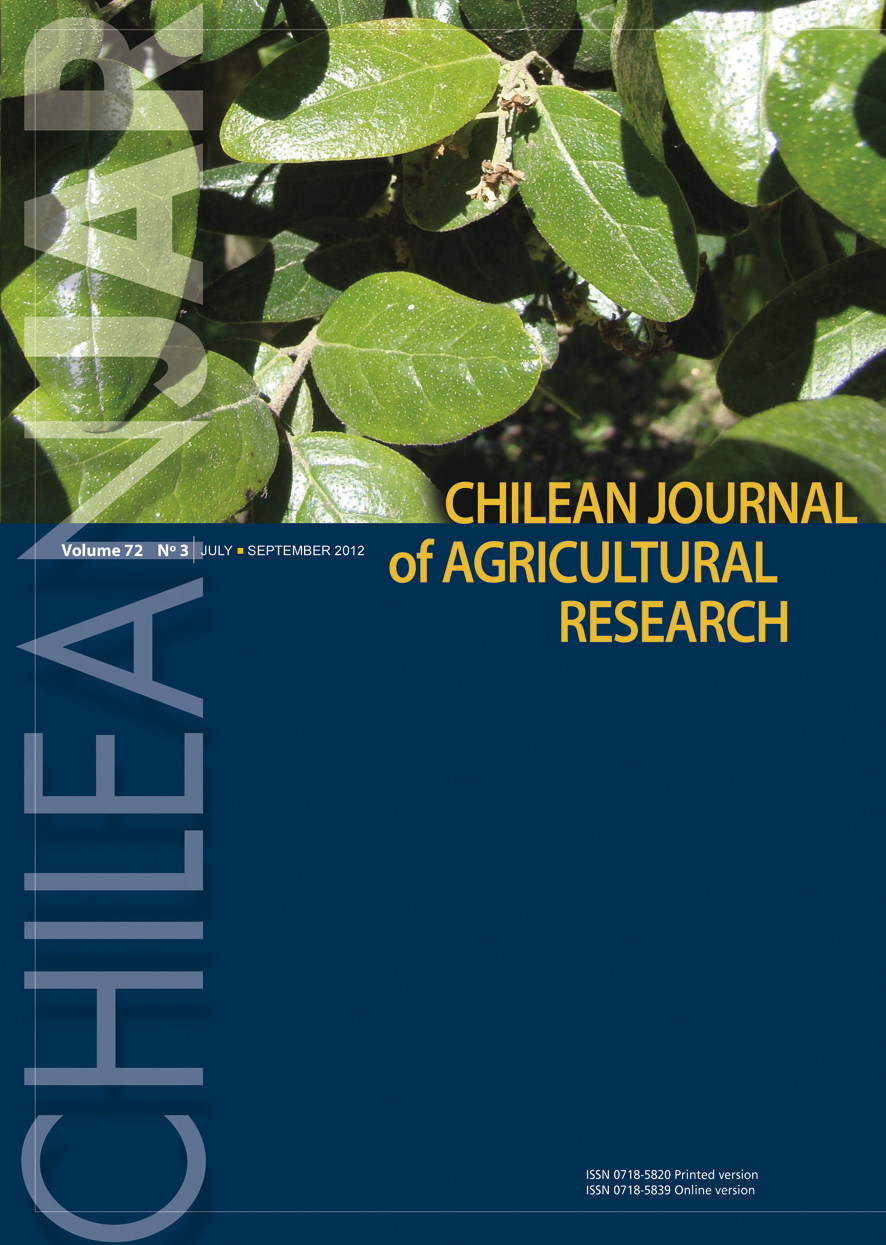
|
Chilean Journal of Agricultural Research
Instituto de Investigaciones Agropecuarias, INIA
ISSN: 0718-5820
EISSN: 0718-5820
Vol. 69, No. 3, 2009, pp. 406-415
|
 Bioline Code: cj09049
Bioline Code: cj09049
Full paper language: English
Document type: Research Article
Document available free of charge
|
|
|
Chilean Journal of Agricultural Research, Vol. 69, No. 3, 2009, pp. 406-415
| en |
Characterization of anatomical, chemical, and biodegradable properties of fibers from corn, wheat, and rice residues
Garay, Rose Marie M.; Rallo, Mónica de la B.; Carmona, René C. & Araya, Jaime C.
Abstract
Anatomical, chemical, and biodegradation properties of fibers from wheat ( Triticum aestivum

L.), rice ( Oryza sativa

L.), and corn ( Zea mays

L.) plant residues and from rice hull were characterized to generate scientific and technical knowledge to support decision making regarding their use. The anatomical and chemical properties were determined following standard procedures. The degree of biodeterioration was analyzed from growth of white rot fungus Pleurotus ostreatus

(Jaq.) Quél. in 30 d under favorable conditions. Afterwards, weight loss was evaluated for each residue. Three replicates were used, plus a control of radiata pine ( Pinus radiata

D. Don) woodchips. The greatest proportion of a-cellulose was found in residues of rice plants (45.1%), with a high amount of extractable (non-structural components, that confer organoleptic characteristics), followed by rice hull (22.78%), which is explained by the presence of silica in their cells. Ash content was higher in wheat residues, reaching up to 18.34%. Anatomical characteristics were studied to corroborate potential use in industrial processes. Fiber length and wall thickness were similar to those of latifoliate wood fibers, although possibly less resistant because of lower lignification. The largest weight loss was from rice plant (32%), followed by rice hull (27%), and corn plants (26.6%). The most resistant was wheat plant (15.8%). All these materials had greater weight losses than the control sample (3.8%). Thus, given their anatomical and chemical properties, the use of plant residue fibers in industrial processes is technically possible, though with concern about their biodegradability.
Keywords
agriculture fibers, biodeterioration, crop residues, Pleurotus ostreatus, white rot.
|
| |
| es |
Caracterización de propiedades anatómicas, químicas y de biodegradación de fibras provenientes de residuos de maíz, trigo y arroz
Garay, Rose Marie M.; Rallo, Mónica de la B.; Carmona, René C. & Araya, Jaime C.
Resumen
Se caracterizaron las propiedades anatómicas, químicas y biodegradación de fibras de residuos de plantas de trigo ( Triticum aestivum

L.), plantas de arroz ( Oryza sativa

L.), plantas de maíz ( Zea mays

L.), y cáscara de arroz, con el objetivo de generar información y tomar decisiones de uso con bases científicas y tecnológicas. Las propiedades anatómicas y químicas se determinaron utilizando procedimientos estándares. El biodeterioro se estudió analizando el crecimiento del hongo de pudrición blanca Pleurotus ostreatus

(Jaq.) Quél. durante 30 días bajo condiciones favorables; y la consiguiente pérdida de peso de cada residuo. Con tres repeticiones, más testigo de viruta de Pinus radiata

D. Don. Mayor proporción de α-celulosa se encontró en arroz (45,1%), con alta cantidad de extraíbles (compuestos no estructurales que aportan características organolépticas) seguido por cáscara de arroz (22,78%), que posee sílice en sus células; el contenido de cenizas fue mayor en trigo (18,34%). Las características anatómicas corroboran las posibilidades de uso en procesos industriales, pues poseen longitud y espesor de pared similar a las fibras de maderas latifoliadas, aunque posiblemente menos resistentes por su menor lignificación. Las plantas de arroz presentaron mayor pérdida de peso (32%), seguida de cáscara de arroz (27%) y plantas de maíz (26,6%); las más resistentes fueron las plantas de trigo (15,8%). Todos los materiales tuvieron pérdidas de peso mayores que la madera (3,8%). Entonces, dada sus propiedades anatómicas y químicas, es técnicamente posible su empleo en procesos industriales, aunque se debe cautelar la biodegradación.
Palabras-clave
biodeterioro, fibras agrícolas, residuos agrícolas, Pleurotus ostreatus, pudrición blanca.
|
| |
© Copyright 2009 Chilean Journal of Agricultural Research.
Alternative site location: http://www.inia.cl
|
|
